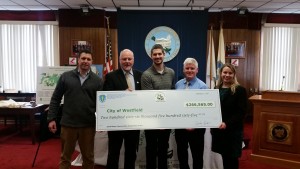CHICOPEE—Several local communities received grants yesterday due to their efforts to become more environmentally conscious.
The grants were given as part of the Green Communities program through the Massachusetts Department of Energy Resources (DOER), and were awarded to communities that focus on renewable energy planning and reducing energy consumption and emissions. Among the 30 communities that received the grants, the municipalities of Westfield, Granville and Blandford were also given Green Community designation through the program.

The Green Communities grant money is presented to Westfield officials by state officials. From left to right: Energy and Environmental Affairs Secretary Matthew Beaton, Westfield Mayor Brian Sullivan, Westfield director of facilities Bryan Forrette, Westfield city advancement officer Joe Mitchell, Department of Energy Resources Commissioner Judith Judson
“This program lowers municipalities’ carbon footprints but it also saves money,” Matthew Beaton, Energy and Environmental Affairs (EEA) secretary, said at the check presentation of the grants in Chicopee’s city council chambers yesterday. “We now have 185 green communities, which is over half of the Commonwealth and 65 percent of the people.”
In order to become a green community, a municipality must meet five criteria that are determined through the Green Communities Act. The criteria are as follows, according to the state’s Energy and Environmental Affairs website:
- Provide as-of-right siting in designated locations for renewable/alternative energy generation, research & development, or manufacturing facilities.
- Adopt an expedited application and permit process for as-of-right energy facilities.
- Establish an energy use baseline and develop a plan to reduce energy use by 20 percent within five years.
- Purchase only fuel-efficient vehicles.
- Set requirements to minimize life-cycle energy costs for new construction; one way to meet these requirements is to adopt the new Board of Building Regulations and Standards (BBRS) Stretch Code.
According to a press release from DOER, each of the municipalities that became green communities had met all five criteria.
Also according to the press release, through DOER’s Green Communities Designation and Grant Program, the state can provide up to $20 million annually to the qualified cities and towns. The goal of the program is to support “communities’ investments in energy efficiency and renewable energy projects that further the clean energy goals determined by designated communities.” The initial designation grants provide a $125,000 funding base for each community, with additional amounts added based on per capita income and population, as well as for municipalities that provide “as of right siting for renewable energy generation.”
The total amount for grants are as follows: Blandford received $138,425; Granville received $139,280; Westfield received $266,565.
“Westfield has been doing projects like this for a while and with this $266,000, we can do even more,” Westfield Mayor Brian Sullivan said. “It will allow us to do some projects that we wouldn’t have gotten to in the city budget otherwise, so it’s money well spent.”
Sullivan added that he thanks the city council for helping to get the criteria passed. They passed the last two criteria in Oct. 2016.
According to Kevin O’Shea, communications director for DOER, the following projects were put forth by the new communities that the funding would be used for. They are:
- In Blandford, lighting upgrades and weatherization at the town’s office building, library, highway garage, post office, water treatment plant, salt shed and fire department.
- In Granville, lighting upgrades and weatherization at the town hall, fire and police stations, library and department of public works barn and a transition to fuel-efficient vehicles.
- In Westfield, lighting upgrades, weatherization projects, heating control systems and refrigeration control upgrades in “just about every municipal building and school.”
O’Shea noted that these projects are tentative and the municipalities will ultimately determine what the funds will be used for.

